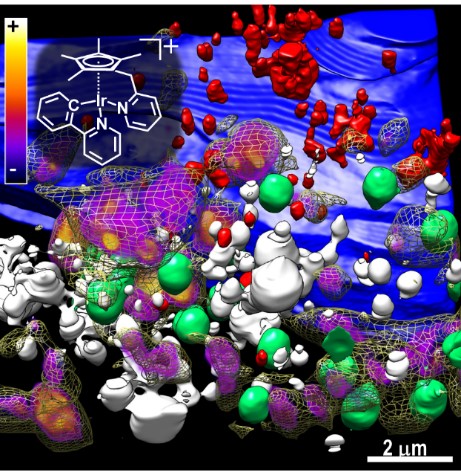RESEARCH PROGRAMMES
P3: Nanomedicine against cancer and infection
RESEARCH SUPERVISOR(S)
Dr. Ana M. Pizarro
Research Group website: https://nanociencia.imdea.org/metallodrugs-to-modulate-cancer-cell-machinery/group-home
Dr. José Javier Conesa
Research Group website: http://www.cnb.csic.es/index.php/es/component/k2/item/1668-correlative-microscopy
RESEARCH TOPIC DESCRIPTION
Cancer is one of the leading causes of death. Despite efforts invested into targeted- and immuno-therapies, current estimates indicate that by 2030 cancer will cause 13M deaths worldwide.
An emerging field promises to provide new ways to modulate the complex chemistry of the cancer cell is intracellular artificial catalysis. Small molecules based on transition metals can facilitate –and amplify– specific chemical reactions inside the cell.
There is a tremendous gap between knowing the chemical behaviour of the metal-based drug candidate and how it relates to cytotoxicity. For most metallodrugs, we do not even know where they are located inside the cell. This gap is undoubtedly the major challenge in their pre-clinical development as studies of organometallic catalytic reactions in living cells are inherently location-specific. Unambiguous understanding of the path of the catalyst inside the cell is mandatory to guide the design of bio-orthogonal catalysts so they can become actual tools in oncology.
We plan to develop and implement correlative approaches combining different imaging techniques including fluorescence, X-ray and electron imaging. Using this new pipelines we will depict the intracellular journey –in a time line– of selected metallodrugs and reveal where they exert their chemistry. Complementary placements at industrial collaborators interested in developing imaging techniques are anticipated. A comprehensive picture of where and where the metal-based catalyst interferes with the cancer cell machinery will enable the development of artificial catalyst to become new tools against cancer.
POSITION DESCRIPTION
The candidate will have strong synthetic skills, in particular in the synthesis of fluorophores. Although experience with cell cultures is not required an understanding of the human cell and a good grasp of molecular biology will be valued (in particular knowledge on mitochondrial structure and function). Expertise in optical, X-ray, and electron microscopy is not a requirement but a strong interest in imaging techniques and in 3D correlative data analysis is necessary to success in this project.
PARTNER ORGANIZATIONS
The topic builds on an existing collaboration with the ALBA Synchrotron, MISTRAL beamline (Angew. Chem. Int. Ed. 2020, 59, 1270-1278). Depending on the evolution of the project, additional secondments may be considered such as DIAMOND Light Source in Oxford or ESRF in Grenoble.

Intracellular allocation of an Ir metallodrug in MCF7 cells by means of cryo-SXT and cryo-XRF.
Iridium metallodrugs are emerging as potent drugs for cancer treatment. We have designed a new iridium-based structure that records the highest cytotoxicity to date. The fate of drugs at nanoscale resolution inside the cell is a challenge not yet met, despite its utmost importance for rational drug design. In collaboration with scientists based at the synchrotrons at both ALBA (cryo soft X-ray tomography) and ESRF (cryo hard X-ray fluorescence tomography), we have unambiguously located –in the intracellular nanospace– the iridium drug, which selectively and exclusively targets the mitochondria. This work is the first 3D-3D overlap of ultrastructure (ALBA) and elemental composition (ESRF) of the cryopreserved cancer cell; no labels, no chemical fixation, no mechanical manipulation (Angew. Chem. Int. Ed. 2020, 59, 1270-1278).
